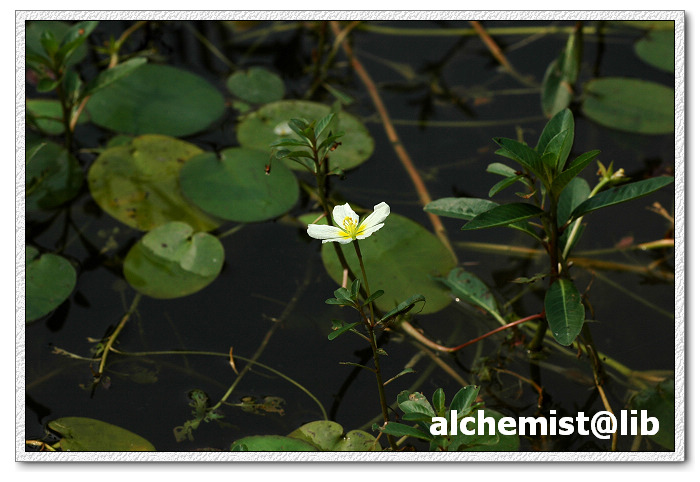- Scientific Name: Ludwigia adscendens (L.) H.Hara
- Ref: J. Jap. Bot. 28:291. 1953
- Synonyms: Cubospermum palustre Lour.; Jussiaea adscendens L.; J. floribunda Griff.; J. fluviatilis Blume; J. repens L.
- English Common Name: water primrose
- Chinese Common Name: 水龙 shuǐlóng, 草里银钗 cǎolǐ∙yínchāi
- Japanese Common Name: ケミズキンバイ [毛水金梅] kemizukinbai
- Family: Onagraceae
- Genus: Ludwigia
- Distribution: Wet swampy places, flooded rice paddies, often floating in water at edges of ponds, tanks, ditches; near sea level to 1600 m. Fujian, Guangdong, Guangxi, Hainan, Hunan, Jiangxi, Taiwan, Yunnan, Zhejiang [India, Indonesia, Japan, Malaysia, Nepal, Pakistan, Philippines, Sri Lanka, Thailand; widespread in Africa, S and SE Asia, Australia].
- Photo: 06/21/2009, South China Botanical Garden, Guangdong
Herbs perennial, with creeping or floating stems, rooting at nodes, with white, erect, short (1-3 cm), spindle-shaped pneumatophores in clusters at nodes of floating stems. Floating stems to 400 cm, terrestrial stems 20-60 cm, much branched, tips ascending, glabrous or densely villous. Petiole 5-20 mm; leaf blade oblong to spatulate-oblong, 0.4-7 × 0.7-3 cm, glabrous, lateral veins 6-13 per side, submarginal vein not prominent, base narrowly cuneate or attenuate, margin entire, apex obtuse to subacute. Sepals 5, deltoid-acuminate, 5-11 mm, glabrous or villous. Petals creamy-white with yellow base, obovate, 9-18 × 6-10 mm. Stamens 10; filaments white, 2.5-4 mm; anthers 0.7-1.8 mm; pollen in monads. Style white, 4-10 mm, glabrous; stigma discoid. Capsule light brown with dark brown ribs, cylindric, terete, 1.2-2.7 cm, 3-4 mm in diam., glabrous or villous, thickly walled, tardily and irregularly dehiscent; pedicel 1.5-5.5 cm. Seeds in one row per locule, firmly embedded in coherent cubes of woody endocarp fused to capsule wall, pale brown, oblong or elliptic, 1.1-1.3 mm, raphe inconspicuous. Fl. Apr-Nov, fr. May-Nov. 2n = 32*. (Flora of China)
